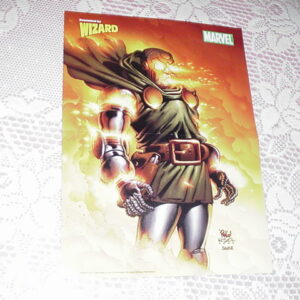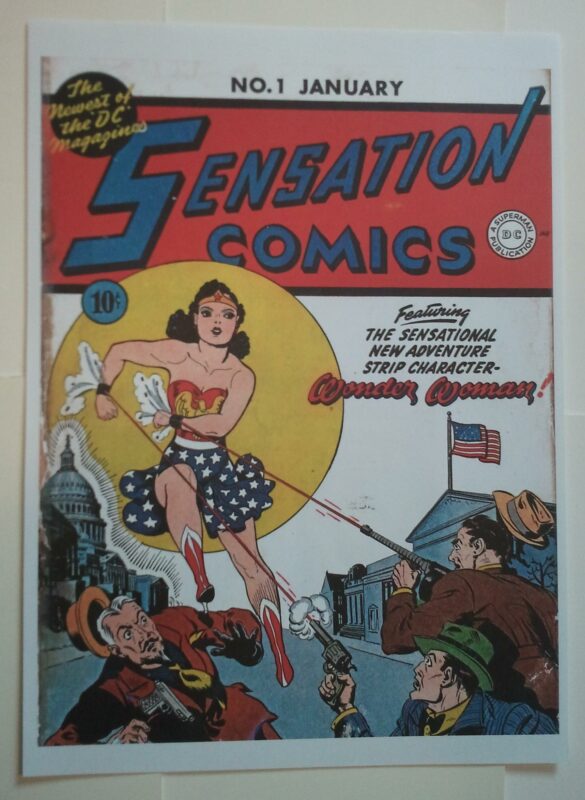Description
Wonder Woman is a superheroine created by American psychologist and writer William Moulton Marston and published by DC Comics. She first appeared in All Star Comics #8 in December 1941 & first cover-dated on Sensation Comics #1, January 1942. The Wonder Woman title has been published by DC Comics almost continuously except for a brief hiatus in 1986. Her depiction as a heroine fighting for justice, love, peace, and sexual equality has led to Wonder Woman being widely considered a feminist icon. Wonder Woman is a warrior princess of the Amazons (based on the Amazons of Greek mythology) and is known in her homeland as Princess Diana of Themyscira. When outside her homeland incognito, she is known as Diana Prince, a secret identity with credentials and identity bought from an Army nurse named Diana White who went to South America and married her fiance. She is gifted with a wide range of superhuman powers and superior combat and battle skills. She possesses an arsenal of weapons, including the Lasso of Truth, a pair of indestructible bracelets, a tiara which serves as a projectile, and, in some stories, an invisible airplane. Created during World War II, the character was initially depicted fighting the Axis military forces, as well as an assortment of supervillains. Since then, Wonder Woman has gained a formidable cast of enemies bent on eliminating the Amazon, including classic villains such as Cheetah, Ares and Circe and newer ones like Genocide and The Circle, as well as many gods and monsters from Greek mythology. Wonder Woman has also regularly appeared in comic books featuring the superhero teams Justice Society (from 1941) and Justice League (from 1960). In addition to the comics, the character has appeared in other media; most notably, the 1975–1979 Wonder Woman TV series starring Lynda Carter, as well as animated series such as the Super Friends and Justice League. Although a number of attempts have been made to adapt the character to live-action film, none have yet emerged. An animated film was released in 2009, with Keri Russell voicing the title role. Attempts to return Wonder Woman to television have faced problems, with a failed NBC Wonder Woman pilot in 2011 counting among more recent attempts. A pilot for The CW entitled Amazon was announced as being in development in September 2012, but by mid-2013 development had been paused due to the network’s dissatisfaction with the script. Wonder Woman has been featured in a variety of toys and merchandise. In an October 25, 1940 interview with the Family Circle magazine, William Moulton Marston discussed the unfulfilled potential of the medium. This article caught the attention of comics publisher Max Gaines, who hired Marston as an educational consultant for National Periodicals and All-American Publications, two of the companies that would merge to form DC Comics. At that time, Marston decided to develop a new superhero. Family Circle published a follow-up article two years later from issue of the Boston University alumni magazine, it was Marston’s wife Elizabeth’s idea to create a female superheroine: William Moulton Marston, a psychologist already famous for inventing the polygraph (forerunner to the magic lasso), struck upon an idea for a new kind of superhero, one who would triumph not with fists or firepower, but with love. “Fine,” said Elizabeth. “But make her a woman.” Marston introduced the idea to Gaines, co-founder of All-American Publications. Given the go-ahead, Marston developed Wonder Woman with Elizabeth, whom Marston believed to be a model of that era’s unconventional, liberated woman. Marston was also inspired by Olive Byrne, who lived with the couple in a polygamous/polyamorous relationship. Both women served as exemplars for the character and greatly influenced the character’s creation. Wonder Woman debuted in All Star Comics #8 (December 1941), scripted by Marston and with art by Harry G. Peter. Wonder Woman was initially named “Suprema” in Marston’s first script, but this name was dropped. Sensation Comics #1 (January 1942) was Wonder Woman’s first cover appearance. Marston was the creator of a systolic-blood-pressure-measuring apparatus, which was crucial to the development of the polygraph (lie detector). Marston’s experience with polygraphs convinced him that women were more honest and reliable than men and could work more efficiently. “Wonder Woman is psychological propaganda for the new type of woman who should, I believe, rule the world”, Marston wrote. In a 1943 issue of The American Scholar, Marston wrote: Not even girls want to be girls so long as our feminine archetype lacks force, strength, and power. Not wanting to be girls, they don’t want to be tender, submissive, peace-loving as good women are. Women’s strong qualities have become despised because of their weakness. The obvious remedy is to create a feminine character with all the strength of Superman plus all the allure of a good and beautiful woman. Initially, Wonder Woman was an Amazon champion who wins the right to return Steve Trevor – a United States intelligence officer whose plane had crashed on the Amazons’ isolated island homeland – to “Man’s World” and to fight crime and the evil of the Nazis. During this period, Wonder Woman joined the Justice Society of America as the team’s secretary. Jon L. Blummer is a Golden Age artist who worked for National Periodicals among others and who created Hop Harrigan and Fighting Yank.
Related products
-


Punisher Poster # 6 by Wieslaw Walkuski Born Frank Castle Origin Movie
$29.99 Add to cart -


Doctor Doom Poster # 3 Triumphant by Mike Wieringo Fantastic Four 67
$34.99 Add to cart -


G.I. Joe Poster # 3 Cobra Commander Storm Shadow vs Snake Eyes and Billy by Mike Zeck
$34.99 Add to cart -


Wolverine Poster #16 vs The Hand The End by David Finch Ninjas
$39.99 Add to cart


